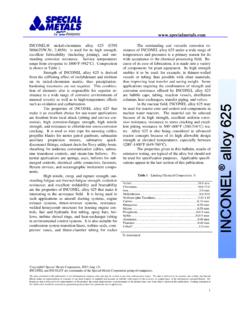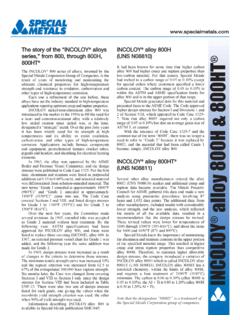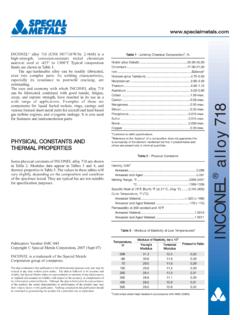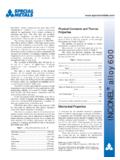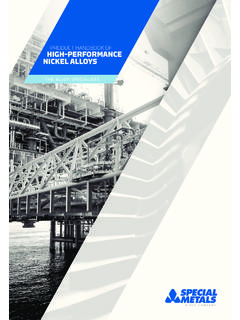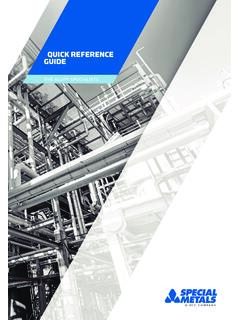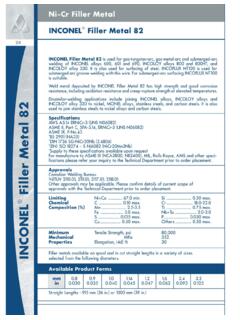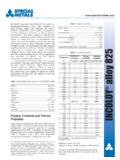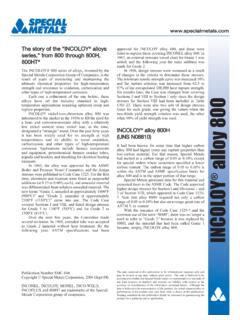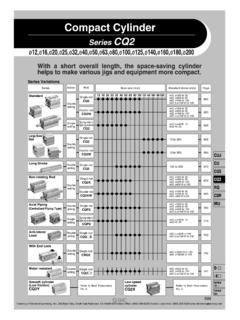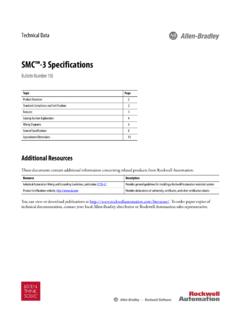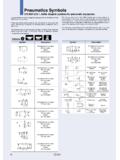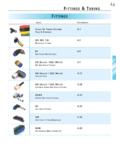Transcription of www.specialmetals
1 INCOLOY alloy alloy 825 (UNS N08825 ) is anickel-iron-chromium alloy with additions ofmolybdenum, copper, and titanium. The alloy schemical composition, given in Table 1, is designed toprovide exceptional resistance to many corrosiveenvironments. The nickel content is sufficient forresistance to chloride-ion stress-corrosion cracking. Thenickel, in conjunction with the molybdenum andcopper, also gives outstanding resistance to reducingenvironments such as those containing sulfuric andphosphoric acids. The molybdenum also aids resistanceto pitting and crevice corrosion. The alloy s chromiumcontent confers resistance to a variety of oxidizingsubstances such as nitric acid, nitrates and oxidizingsalt. The titanium addition serves, with an appropriateheat treatment, to stabilize the alloy againstsensitization to intergranular resistance of INCOLOY alloy 825 to generaland localized corrosion under diverse conditions givesthe alloy broad usefulness.
2 Applications includechemical processing, pollution control, oil and gasrecovery, acid production, pickling operations, nuclearfuel reprocessing, and handling of radioactive for alloy 825 are similar to those forINCOLOY alloy 11- Limiting Chemical Composition, % of INCOLOY alloy 825 Nickel .. CCoonnssttaannttss aanndd TThheerrmmaallPPrrooppeerrttiieessSome physical constants for INCOLOY alloy 825 arelisted in Table 2. Values for thermal expansion, thermalconductivity, and electrical resistivity at varioustemperatures are in Table 3. Modulus of elasticity andPoisson s ratio over a range of temperatures are given inTable 4. Modulus values, which were determineddynamically, were used to compute Poisson s 22- Physical ConstantsDensity, Range, F.
3 2500-2550 C ..1370-1400 Specific Heat, Btu/lb F .. C ..440 Curie Temperature, F ..<-320 C ..<-196 Permeability at 200 oersted ( kA/m) .. 33- Thermal PropertiesTTeemmppeerraattuurreeEElleecc ttrriiccaallRReessiissttiivviittyyTThhee rrmmaallCCoonndduuccttiivviittyyCCooeeff ffiicciieenntt ooffEExxppaannssiioonnaaoohhmm cciirrcc mmiill//ffttBBttuu--iinn//fftt22 hh FF1100--66iinn//iinn FF 793 mmWW//mm CC mm//mm CC coefficient of linear expansion between 80 F (27 C) andtemperature data contained in this publication is for informational purposes only andmay be revised at any time without prior notice. The data is believed to beaccurate and reliable, but Special Metals makes no representation or warranty ofany kind (express or implied) and assumes no liability with respect to theaccuracy or completeness of the information contained herein.
4 Although thedata is believed to be representative of the product, the actual characteristics orperformance of the product may vary from what is shown in this contained in this publication should be construed as guaranteeing theproduct for a particular use or Number SMC-030 Copyright Special Metals Corporation, 2004 (Sept 04)INCOLOY, INCONEL, INCO-WELD and 686 CPT aretrademarks of the Special Metals Corporation group aallllooyy 8822552 TTeemmppeerraattuurreePPooiissssoonn ssRRaattiiooSShheeaarrMMoodduulluussYYoo uunngg ssMMoodduulluussGGPPaaGGPPaa CCTT eemmppeerraattuurreePPooiissssoonn ssRRaattiiooSShheeaarrMMoodduulluussYYoo uunngg ssMMoodduulluuss110033kkssii110033kkssii PPrrooppeerrttiieessINCOLOY alloy 825 has good mechanical properties from cryogenic temperatures to moderately high temperatures.
5 Exposureto temperatures above about 1000 F (540 C) can result in microstructural changes (phase formation) that significantly lowerductility and impact strength. For that reason, the alloy is not normally used at temperatures where creep-rupture propertiesare design properties at room temperature are listed in Table 5. As indicated, the alloy can be strengthened substantially bycold tensile properties are shown in Figure 1. The tests were conducted on cold-drawn rod of (19-mm) diameter annealed at 1725 F (940 C)/1 yield strength of the alloy is similar to tensile yield strength. Tests on annealed rod of (25-mm)diameter produced a compressive yield strength ( offset) of 61,400 psi (423 MPa) compared with a tensile yield strengthof 57,500 psi (396 MPa). Ultimate tensile strength of the material was 104,500 psi (720 MPa).
6 INCOLOY alloy 825 has good impact strength at room temperature and retains its strength at cryogenic 6 gives the results of Charpy keyhole tests on 55- Typical Room-Temperature Tensile PropertiesTubing, Annealed1127726444136 Tubing, Cold Drawn145100012988915 Bar, Annealed1006904732445 Plate, Annealed966624933845 Sheet, Annealed1107586142139 FFoorrmm aannddCCoonnddiittiioonnEElloonnggaattii oonn,,%%kkssiikkssiiMMPPaaMMPPaaTTeennss iillee SSttrreennggtthhYYiieelldd SSttrreennggtthh(( OOffffsseett))FFiigguurree tensile properties of annealed the typical usage , ksi Elongation, %Temperature, FTemperature, CStress, MPaTTaabbllee 44- Modulus of Elasticity (Hot Rolled and Annealed Plate)Tensile StrengthElongationYield Strength( Offset)OOrriieennttaattiioonn FF CCfftt--llbbJJTT eemmppeerraattuurreeIImmppaacctt SSttrreennggtthhaaTTaabbllee 66- Charpy Keyhole Impact Strength of of three aallllooyy 8822553 CCoorrrroossiioonn RReessiissttaanncceeThe outstanding attribute of INCOLOY alloy 825 is its high level of corrosion resistance.
7 In both reducing and oxidizeenvironments, the alloy resists general corrosion, pitting, crevice corrosion, intergranular corrosion, and stress-corrosioncracking. Some environments in which INCOLOY alloy 825 is particularly useful are sulfuric acid, phosphoric acid, sulfur-containing flue gases, sour gas and oil wells, and sea details on the corrosion resistance of alloy 825, refer to Special Metals publication Restistance to AqueousCorrosion , on the website, standard machining operations are readily performed onINCOLOY alloy 825. The alloy normally has optimummachining characteristics in the annealed temper. Toolingand procedures described for Group C alloys should be used;for more information refer to Special Metals publication Machining , on the website, aanndd CCoolldd FFoorrmmiinnggThe hot-working range for INCOLOY alloy 825 is 1600 to 2150 F (870 to 1180 C).
8 For optimum corrosion resistance, finalhot working should be done at temperatures between 1600 and 1800 F (870 and 980 C).Cooling after hot working should be air cool or faster. Heavy sections may become sensitized during cooling from thehot-working temperature, and therefore be subject to intergranular corrosion in certain media. A stabilizing anneal (see above)restores resistance to corrosion. If material is to be welded or subjected to further thermal treatment and subsequently exposedto an environment that may cause intergranular corrosion, the stabilizing anneal should be performed regardless of coolingrate from the hot-working properties and practices are essentially the same for INCOLOY alloy 825 as for INCONEL alloy work-hardening rate is somewhat less than for the common grades of austenitic stainless steels, it is still relativelyhigh.
9 Forming equipment should be well powered and strongly built to compensate for the increase in yield strength withplastic information on hot and cold forming can be obtained by visiting the website alloy 825 has good weldability by allconventional processes. For most applications, INCONEL Welding Electrode 112 for shielded metal-arc welding andINCONEL Filler Metal 625 for gas-shielded processes areused. For applications that require highest resistance tocorrosion, INCO-WELD Welding Electrode 686 CPT andINCO-WELD Filler Metal 686 CPT are used. Information onsurface preparation, joint design, and welding technique canbe obtained in the Special Metals publication Joining , onthe website, alloy 825 products are heat treated during manufacturing at the mill to develop the optimum combination ofstabilization, corrosion resistance, mechanical properties, and formability.
10 To maintain these properties during fabrication,subsequent anneals should be performed between 1700 to 1800 F (930 to 980 C) followed by rapid air cooling or waterquenching. Heat treatment in the lower end of the range is acceptable for stabilization. However, annealing at temperaturesin the higher end of this range may be preferred for softness and grain structure for forming and deep-drawing whilemaintaining corrosion resistance. Quenching is usually not necessary for parts of thin cross section ( , sheet, strip and wire),but may be desired to avoid sensitization in products of heavier cross section. General procedures for heating, forming,pickling, and finishing are found in the SMC bulletin Fabricating . Welding, brazing, and soldering techniques are discussedin Joining.
